Manchester City versus Everton should be a game that is decided before the game even starts.
Over the last few years, the home team has been the most dominant force in English — and maybe even European — football, winning multiple Premier League titles and a UEFA Champions League trophy.
But these last two months have been nothing but pain for Pep Guardiola and his superstars.
With only four points out of their last eight league games, a loss to Sporting Lisboa in the Champions League, and bottling a 3-0 lead against Feyenoord in the final 15 minutes of the game, Manchester City have had nothing going for them in these last couple of games.
On the other hand, Everton are not too hot right now, either.
While they are not as deep in the relegation battle as they were a couple of years ago, Sean Dyche and his men are still stuck in the bottom third of the table again this season.
Their biggest struggle is scoring goals.
While eight goals from set pieces is a very nice stat, scoring only 14 goals overall and six goals from open play in 16 games is just plain bad.
There is nothing positive to say about the Toffees' attacking play.
Now, these two struggling teams face off on Boxing Day 2024 and want to end their dire streaks to gift their fans a nice three points for Christmas.
In this tactical analysis and post-match report, we will examine how the game played out, what both managers did with their teams, and what the deciding factors were.
Players & Formations Used
For Pep Guardiola and Manchester City, injuries have not been kind to them, and therefore, the team pretty much lined up itself based on the remaining troops.
Stefan Ortega Moreno started in goal with a backline consisting of Rico Lewis, Manuel Akanji, Nathan Aké and Josko Gvardiol in front of him.
Mateo Kovacic played as a holding midfielder, with Bernardo Silva and Phil Foden moving around and attacking midfielders in the half-spaces.
Savinho and Jeremy Doku played on the wings in attack to provide service for looking-for-form superstar striker Erling Haaland.
On paper, the team's formation was a 4-3-3, but even at its lowest, the team still possesses a very fluid, Guardiola-style approach to the game.
Rico Lewis pushed into midfield frequently, Kovacic dropped back into the backline often, and Savinho sometimes played as more of a wingback when they formed a back-three, so Manchester City did not have a real formation in this game.
Looking at Everton, Dyche has used a 4-3-3 formation all season, but given their defensive play, it was a 6-4-0 or 6-3-1 formation for most of the game.
Jordan Pickford started in goal, and Séamus Coleman, Tarkowski, Branthwaite, and Mykolenko started as Everton's back four.
Dyche uses three defensive midfielders: Doucouré, Idrissa Gueye, and Mangala.
Doucouré is the most attacking of the three, while the other two play defensive roles.
In attack, Ndiaye and Jack Harrison played on the wings to help out the lone striker, Calvert-Lewin, who tends to be a bit isolated in the games this season.
Another thing that needs to be noted is the bench for City.
While Ilkay Gündogan and Kevin de Bruyne sat on the bench, they were not fully healthy, and the other substitutes were all youth players, so there was not a lot of room for Pep Guardiola's subs in this game.
Man City Between Anger & Guilt
The game started off with a lot of pressure from the side of City
Pep Guardiola's formation had his men play with an attacking mindset and a fierce attacking press to put them ahead early on in the game and maybe gain some confidence after the last couple of weeks.
City triggered their press on the goalkeeper through Haaland, and although Pickford is not the greatest ball-playing goalkeeper in world football right now, they had some early success with that.
Another positive thing was their counter-press.
City could retain possession a lot through the first 25 minutes of the game and recovered the ball well after losses.
Still, Everton also had a lot of struggles out of their very defensive shape and could not find solutions in the passing game at all.
Overall, City looked as sharp as you would have expected them to look.
In possession, City were struggling a bit, however.
While the team could retain possession for extended periods of time with no troubles whatsoever and showed great ball security against the weak attempts of a midfield press that Everton tried to play, they could not progress the ball effectively at all.
They used two main variants in possession, which we will take a look at now.
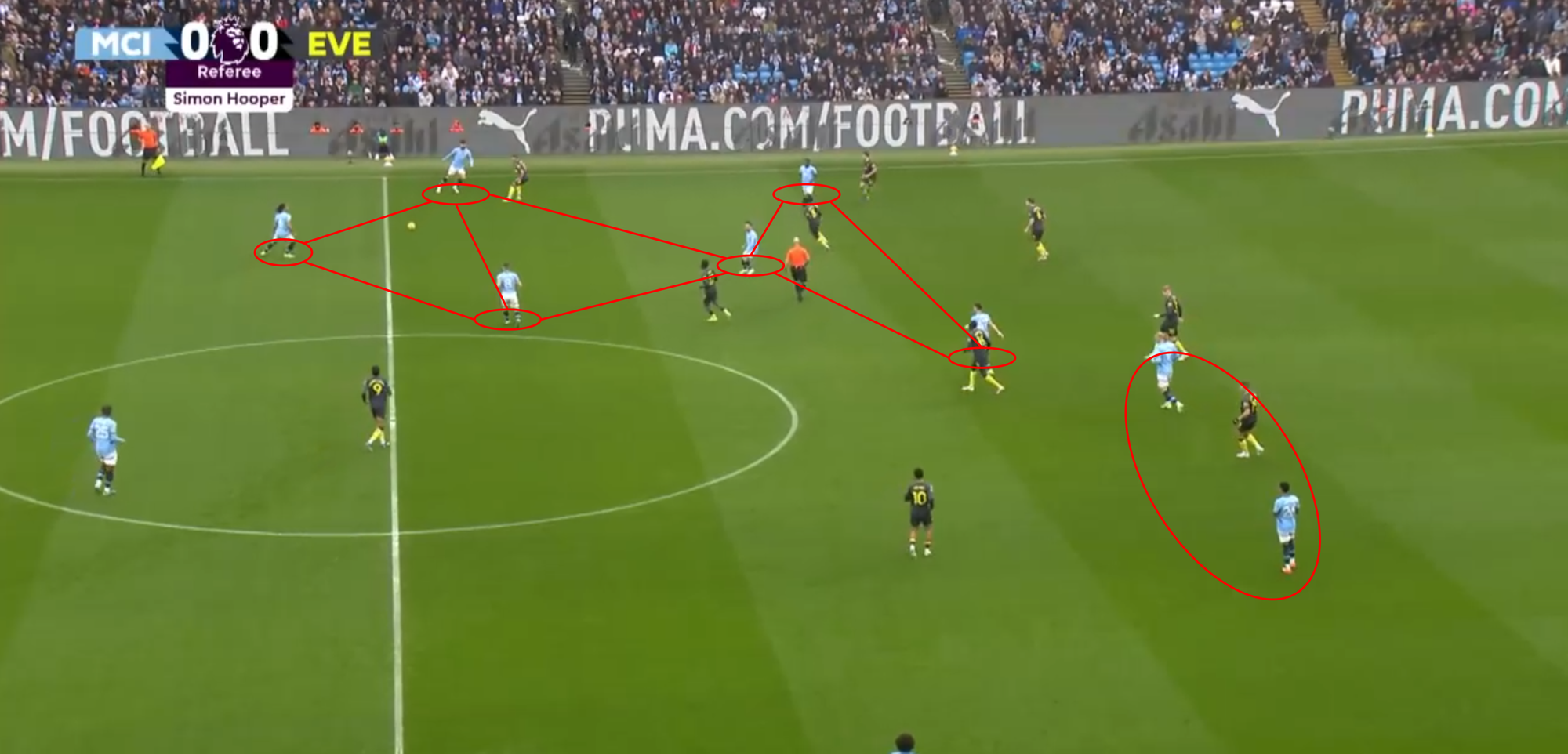
The first way of building up their play was relatively simple, and it was a Guardiola classic, a heavy overload of one side of the pitch.
Here, seven City players are on the left side of the pitch, forming three triangles and, subsequently, diamonds.
The players always had multiple options to pass the ball to.
They had a numerical advantage on that side of the field, so they could let the ball circulate there without any problems against an Everton team that was not too keen on taking risks in terms of their press.
Another interesting tidbit is that both attackers in a high position against the backline are on the far side of the field compared to the ball.
Especially when City were overloading their left side, the moment they were able to open up one of their midfielders, both attackers made diagonal runs behind Everton's backline, and City instantly played a long ball over the top, something we didn’t see a lot from Guardiola-managed teams in the past.
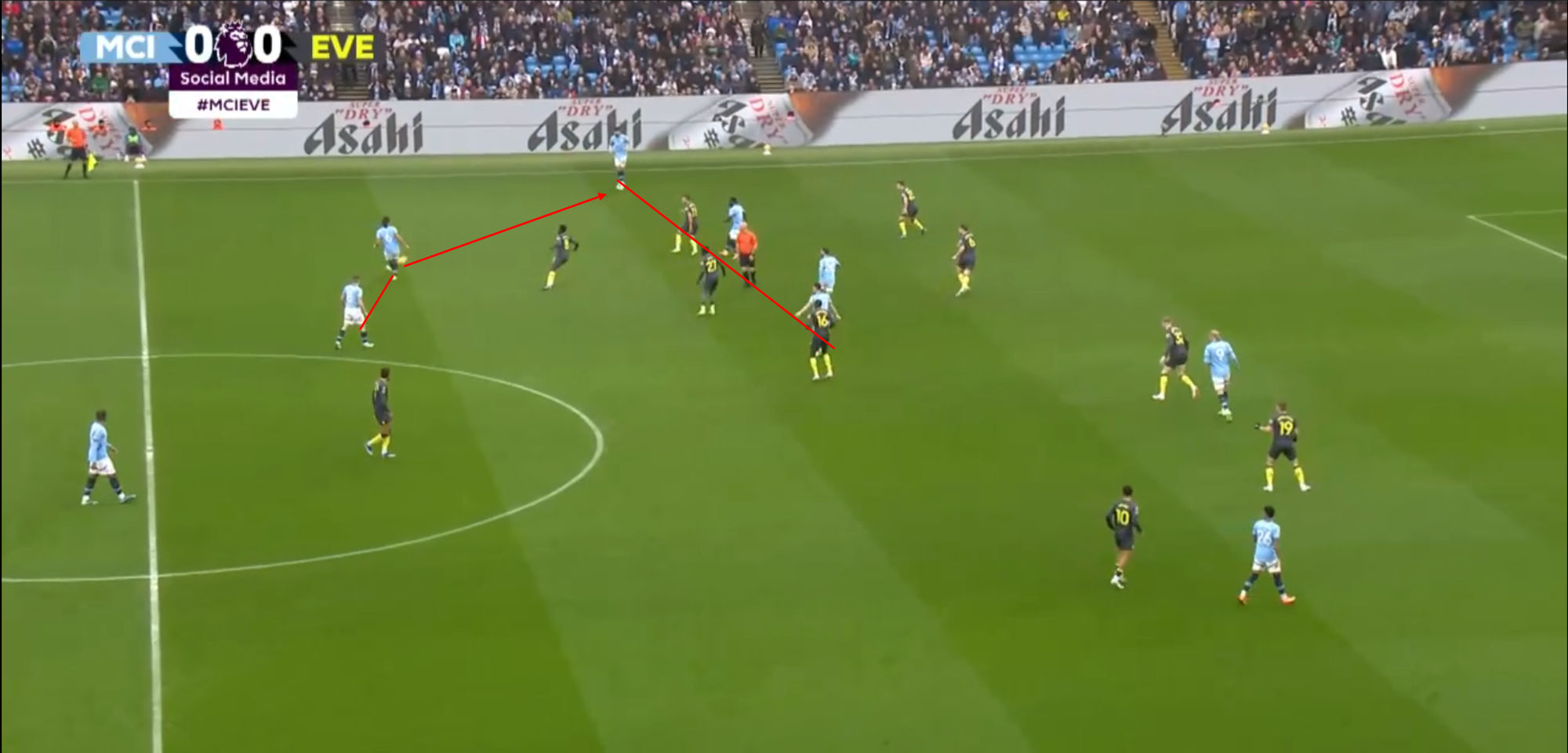
Still, their positional play was not good at all once again.
While the base of thought was good, the executions once again lacked the attention to detail that set City apart in the last couple of years.
The picture above shows one of the minor issues that Guardiola’s men had on Boxing Day.
While the overload was successful, Everton did not drag themselves out of position to allow a pass to a player between the lines.
The City players now try to find different solutions but end up with four players on one line in midfield, right where the Everton block starts.
Kovacic is also way too close to Aké in this situation.
Therefore, a switch is impossible, which leaves Aké with only one option to pass it to, Gvardiol near the sideline, but then Gvardiol has the same problem.
In the end, City scored out of this structure in the build-up, but more because of their individual class and a bit of luck rather than because of a well-constructed attack.
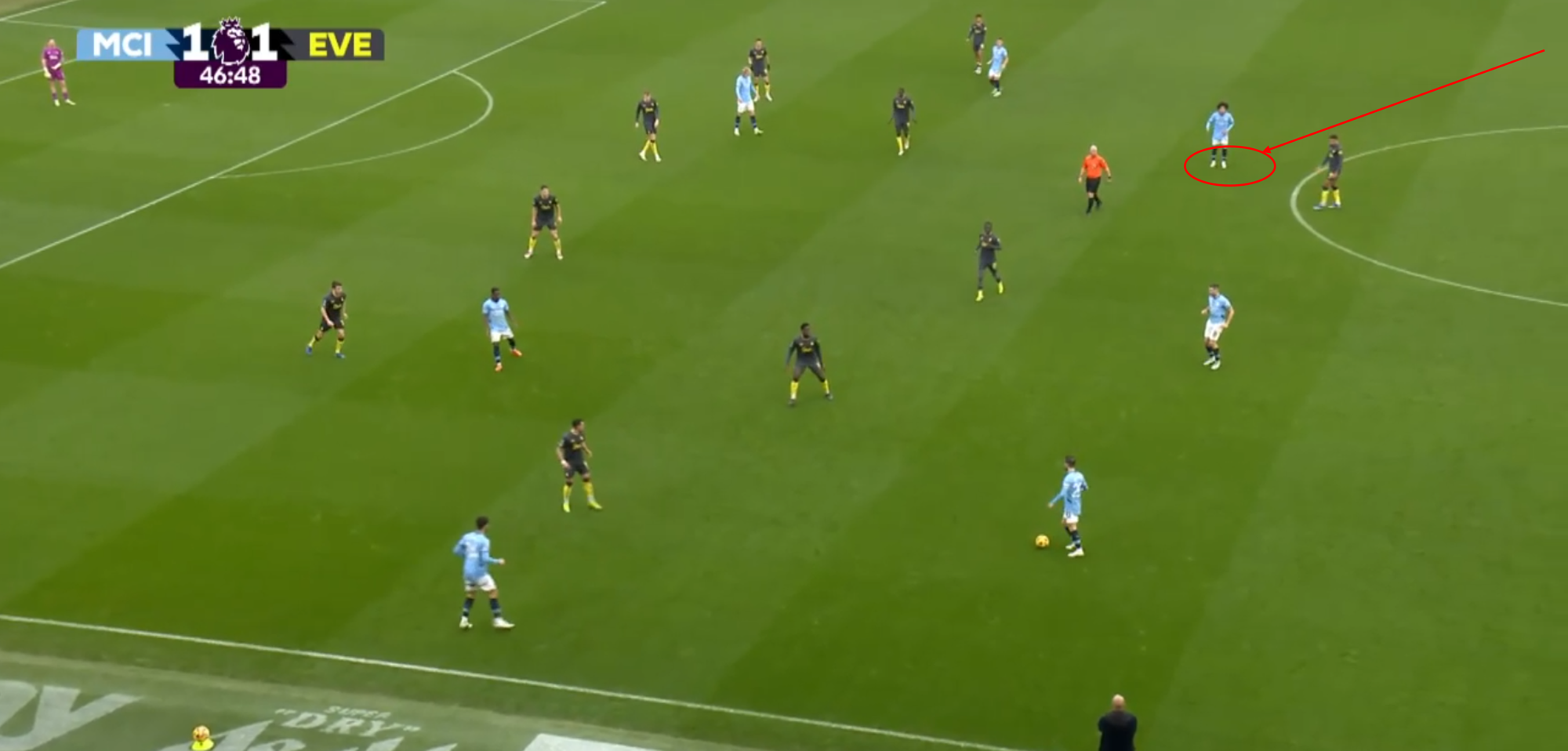
The second way City built their play in this game was a bit different.
Right-back Rico Lewis was pushing inside into the midfield, while one midfielder was dropping out sidewards, and Savinho becoming a wingback on the right side of the field.
This allowed City to play a 3-4-2-1 formation, which helped them start the second half of play.
Man City had more width in this shape, which allowed them to spread the Everton backline out.
This enabled Foden to take more good actions in the half-spaces and quick switches through Lewis to Savinho.
It also opened up the possibility of runs behind the backline with good movement.
Here, Doku drops back a bit while Gvardiol and Bernardo are making runs towards the defensive line.
This forced the Everton defence into more decisions and movement, creating a couple of good opportunities for City in the first couple of minutes of the second half, but they were not able to capitalise.
Overall, Everton defended well, but City lacked the ideas to play through that deep block and got angry during the game, ending up in multiple losses that they never had before.
Also, even after taking the lead, City could not gain some confidence and dominate the game like they usually do.
Instead, Guardiola's style of play had his men stop the attacking press, soften the counter-press and drop back into a mid-block, something that City never did against inferior competition under the Spaniard.
This decision then leads to what we are looking at next.
Man City Defending Against Everton
As stated in the introduction, Everton have been really bad going forward.
Sean Dyche has never been an attacking mastermind, but what Everton are doing so far this season is baffling.
They defend well, yes, but they are an incredibly harmless team going forward—especially for a team in a top-five league.
Still, they managed to score their seventh goal out of open play against City on Boxing Day, but once again, it was something City should have done better with.
The situation started with Doku's unnecessary loss.
He tried to take on two defenders just metres away from his box, leading to one of the few high regains Everton had this game.
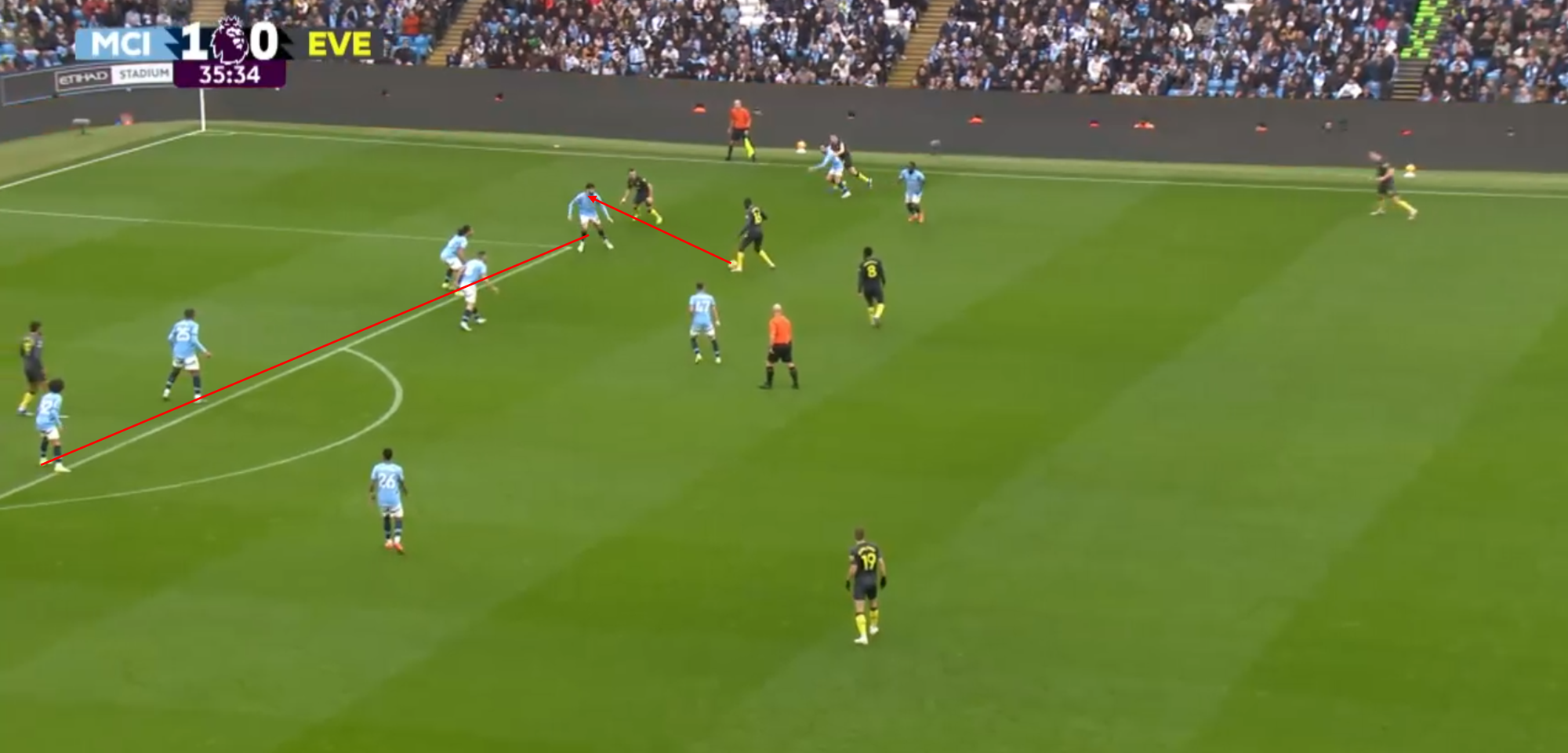
From there on, Doucouré had the ball at the corner of the box, but Man City did very well in the first instance of defending here and showed a lot of the key principles that Guardiola implemented in his time there.
The line holds its position very well.
It does not drop deep into its own box; instead, it pushes forward, playing Calvert-Lewin offside and preventing an early cross.
Gvardiol and Bernardo are taking on the runs made by the Everton attackers, leaving Doucouré with only one option.
But now things get bad already.
Not a single City player is actively trying to press Doucouré, who is just standing there at the edge of the box, even though the team is there.
Kovacic is standing in a no-man's land only half a metre away from Aké, which is not covering anything.
Akanji now gambles on the pass way too early and drops back into the box before the pass is even played, which was just unnecessary.
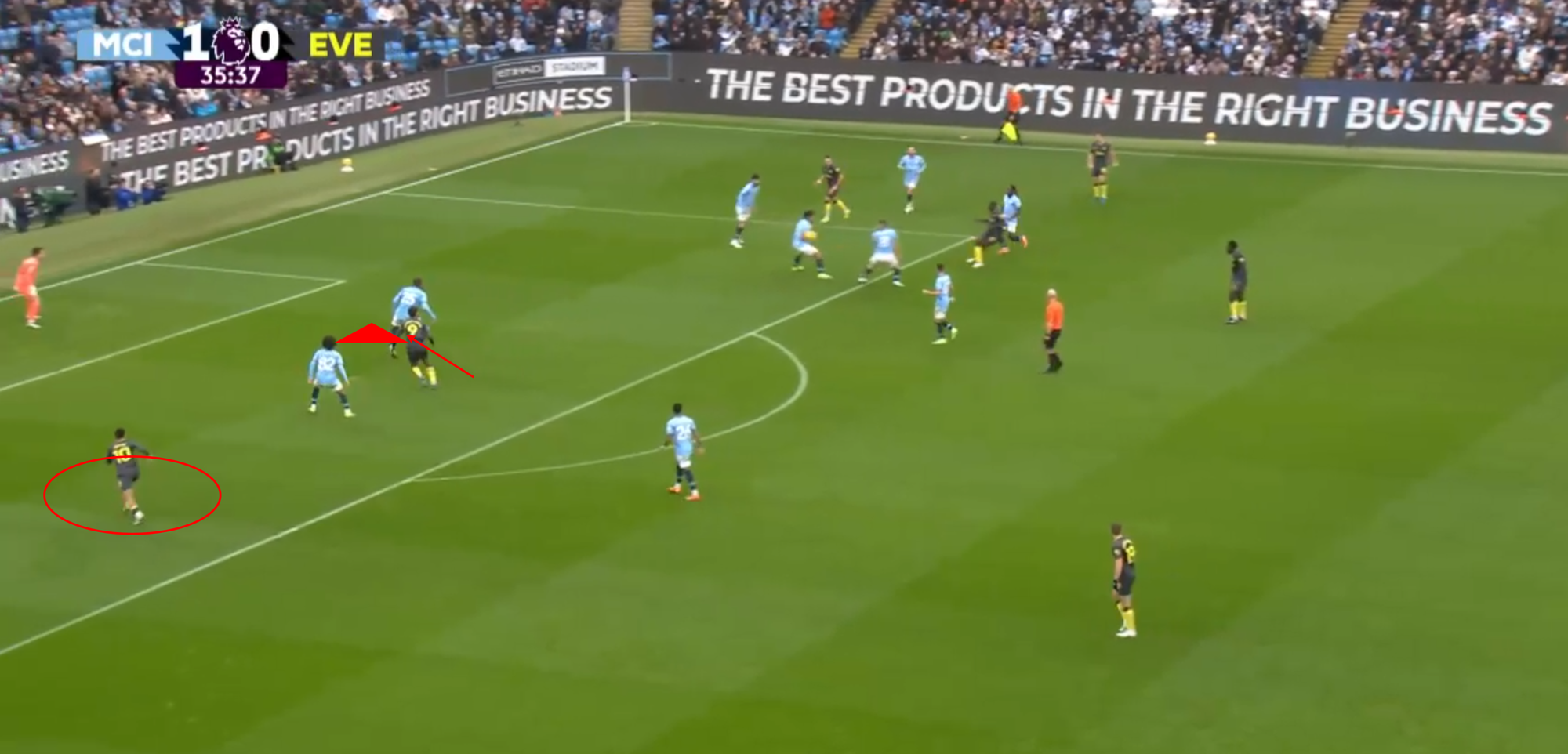
From there on, things get even worse.
Even though six Man City players are crowding the area around the ball, not one of them is pressing Doucouré.
The entire team is expecting the pass to go to the winger.
Doucouré is now simply dribbling forward and crossing himself because no City player can block that from their position.
In the box, Akanji is now in a bad spot for that cross because he reacted early to a pass that hadn’t been played and could not clear the ball away.
Rico Lewis is only looking towards the ball and did not check over his shoulder once, so he left Ndiaye wide open on the far post.
Both City defenders are in front of their attackers, but against a team like Everton with their struggles and with the fact that they are constantly crossing the ball into the box towards their target man, City need to realise that they need to mark the players tighter in this situation.
Now, chaos unfolds.
Akanji misses the ball, and Ndiaye has enough time to control it before Lewis is able to close him out.
Lewis finishes well, levelling the game.
It is completely unnecessary for Guardiola and his men.
Still, once again, they are just not playing with the right intensity and making bad decisions in the final details of these situations.
Sean Dyche's Style Of Play & Tactics
Everton were in a tough spot in this game once again.
Their season has also been subpar, and given their attacking struggles, they would not stand a chance against City under normal circumstances.
Trying to create an open game against a team like Man City would not make sense.
So, once again, Sean Dyche comes in.
Dyche has long managed in the Premier League, and people have come to know his playstyle, lovingly giving it the nickname "Brexit-Ball."
With his throwback style of hard, physical football focused on defending, kick and rush elements and good set-pieces, Dyche's playing style has his teams playing in a way which was more common 20 years ago.
Well, not really, obviously he wouldn’t be as successful as he is without adaption to the modern game.
Still, his Everton team is a pain to play against for top teams.
They are currently in a stretch of games in their season that should be tough on them with consecutive games against Liverpool, Arsenal, Chelsea and City.
Still, after the Merseyside Derby was postponed, they've now drawn against the other three top teams and only conceded on goal in these three games (by the way their next games are against Forest, Bournemouth, Aston Villa, Spurs and Brighton, so we are going to see a lot more of this in the coming weeks).
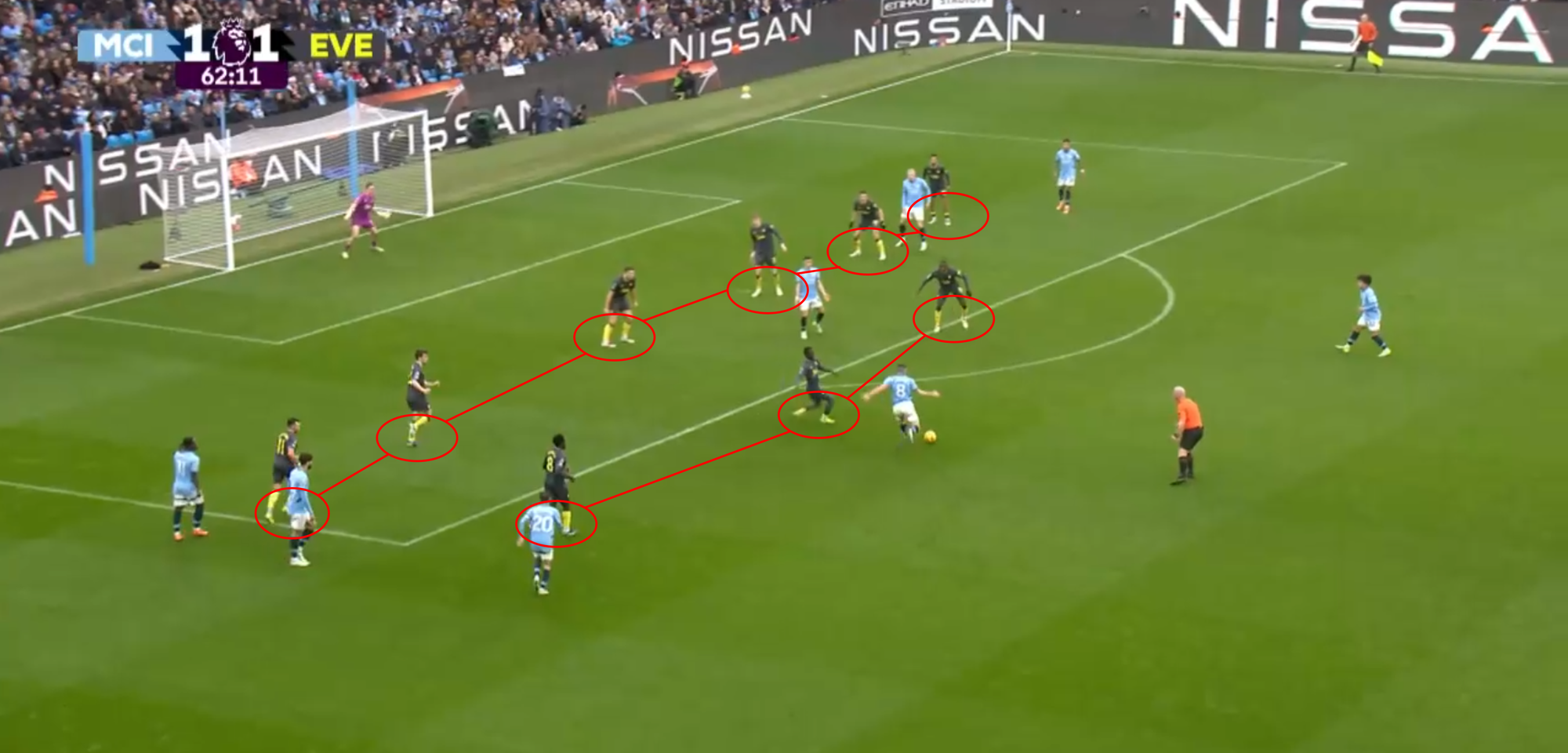
How are they doing it?
Well, Dyche is not someone who has too much pride in him to try to play anything but defence against a team coached by Guardiola.
Looking at their defensive shape, they played in a 6-3-1 shape for most of the game.
Everton crowded the box and kept spaces condensed, so City could not make controlled passes into the box or take shots without an Everton player blocking or at least deflecting them.
With so many players in the box, Haaland was never able to gain any separation and always had a defender right behind.
Branthwaite did an exceptional job at always getting to the Norwegian striker and preventing him from having controlled actions.
City could not play through that deep block.
Everton prevented crosses from dangerous areas, crowded the middle of the field, had their midfielders prevent shots from the edge of the box, and played incredibly physically in their direct duels — the epitome of Sean Dyche's style of play.
Still, they did not play a good game, honestly, for multiple reasons.
You can’t contain a team like City like that for 90 minutes.
City missed a penalty, Gvardiol hit the post with a header, and Bernardo missed a sitter.
If only one of these ends up as a goal, the game is out of reach for the Toffees, and once again, only City is to blame for not scoring; Everton did nothing to prevent that.
Secondly, their attacking play was nonexistent because of their defensive approach.
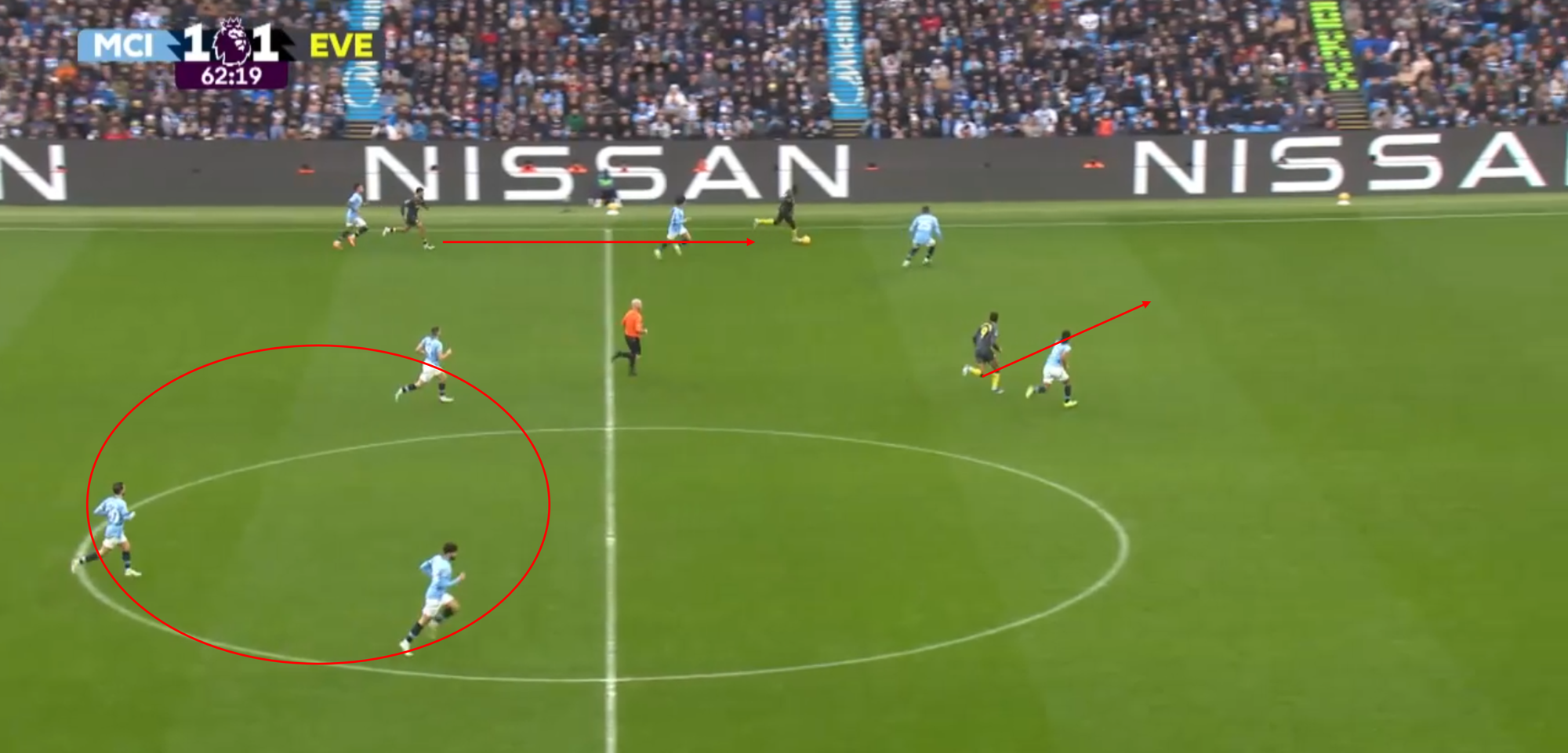
Even if they won the ball somehow, they were not able to do anything at all.
Here, City had a cross blocked, and Ndiaye was able to recover a second ball, which was a rare occasion in itself and managed to play a pass to Doucouré.
But now what?
Calvert-Lewin is making a run towards the same wing that Doucouré is on and in the middle of the field, only City players are making recovering runs, not a single Everton player is even trying to move forward.
Therefore, Akanji easily defended the counterattack, and City recovered possession after about ten seconds of losing it—poor from Everton.
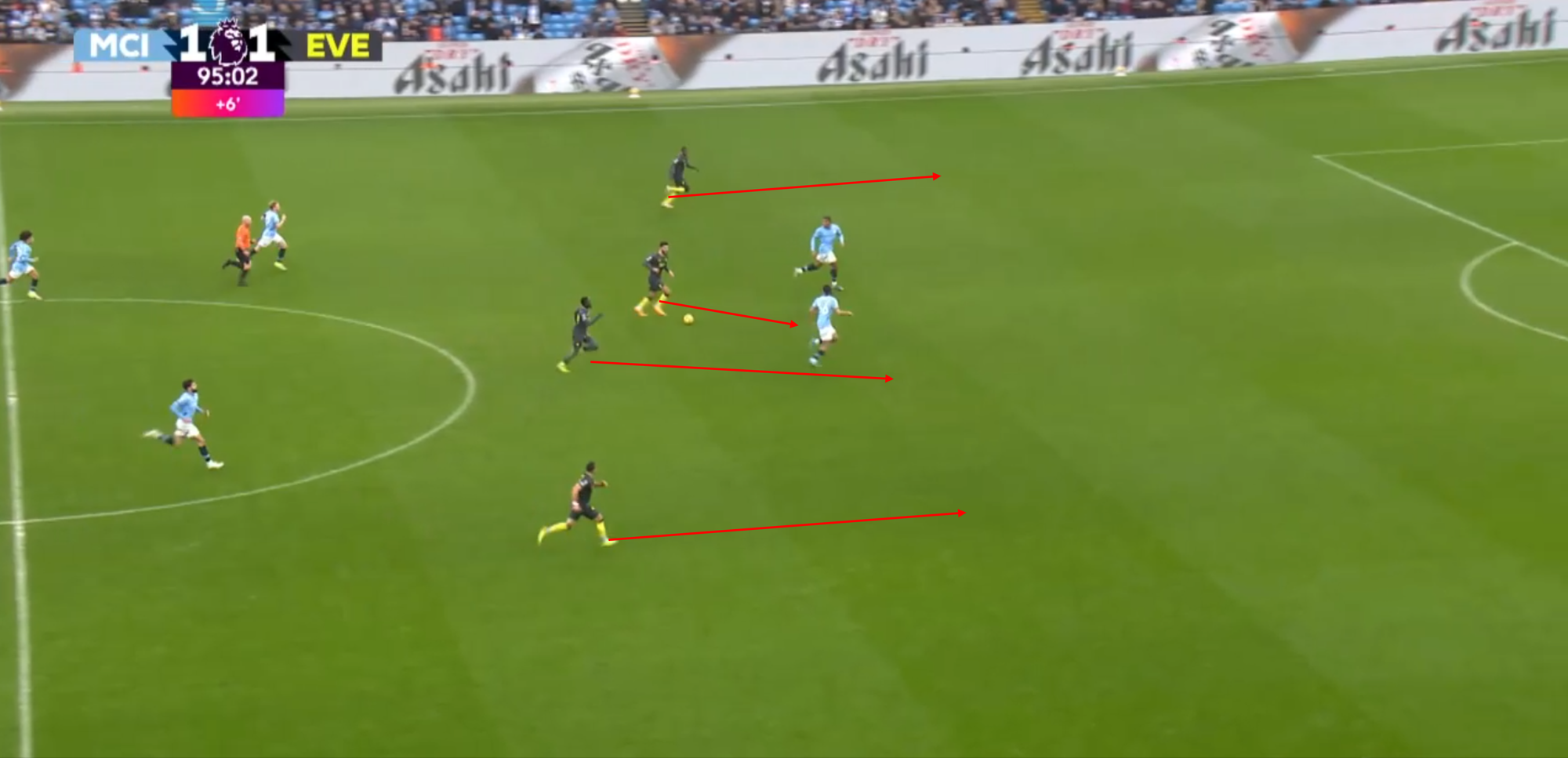
Their counterattacks lack everything; there is not a single positive thing to say about it, and that’s rough for a team in desperate need of goals.
In added time, City once again gave away the ball for no reason, and with one minute to go, Everton were in a 4v2 counterattacking situation.
You’d think that this is the situation where City just threw away the game once again, but oh well, here comes Sean Dyche’s Everton.
All four players are just running in a straight line.
Broja dribbles towards the defender but has his eyes locked on a passing option from the start.
He then dribbles too close to the defender and has to play a backwards pass to Harrison, throwing away all the momentum the attack had.
Harrison then cuts inside, and the other players just stand there watching as Harrison’s shot is blocked by Akanji.
The players simply did not know what to do in this situation, and Dyche tactically needs to fix this if he wants his team to win more games.
Conclusion
Looking at the game, Manchester City were the better team, but it didn’t matter at all.
One reason for that definitely was Dyche’s very defensive approach.
Everton did really well crowding the box and preventing Manchester City from penetrating it.
They also played well in their backline as a collective and moved and marked the City players well.
On the other hand, they honestly did not do anything but fight and try to play long balls to Calvert-Lewin.
They had multiple good opportunities for counters, but with their defensive mindset and shape, they were not able to capitalise at all.
For Pep Guardiola tactics, it was the same as in the last weeks.
It was just obvious that his team was rattled by the lack of good results and that he was trying too hard to find solutions.
Seeing City drop back against Everton and letting them keep possession is something that we would not have seen a couple of weeks ago, and it’s not a good sign.
On the other hand, they can only blame themselves for losing this game once again.
They were the better team, had better opportunities, and defended well in most situations, but once again, they failed to convert in the most important situations.
Bernardo Silva missed a sitter, and then Akanji made a crucial mistake, which prevented them from being up at the half.
Then Haaland missed the penalty, and they once again crumbled under their self-made pressure.
In the end, the point is more valuable to Everton in the relegation battle, but both teams managed to shake off their bad habits, and therefore, no manager can be happy with the game.

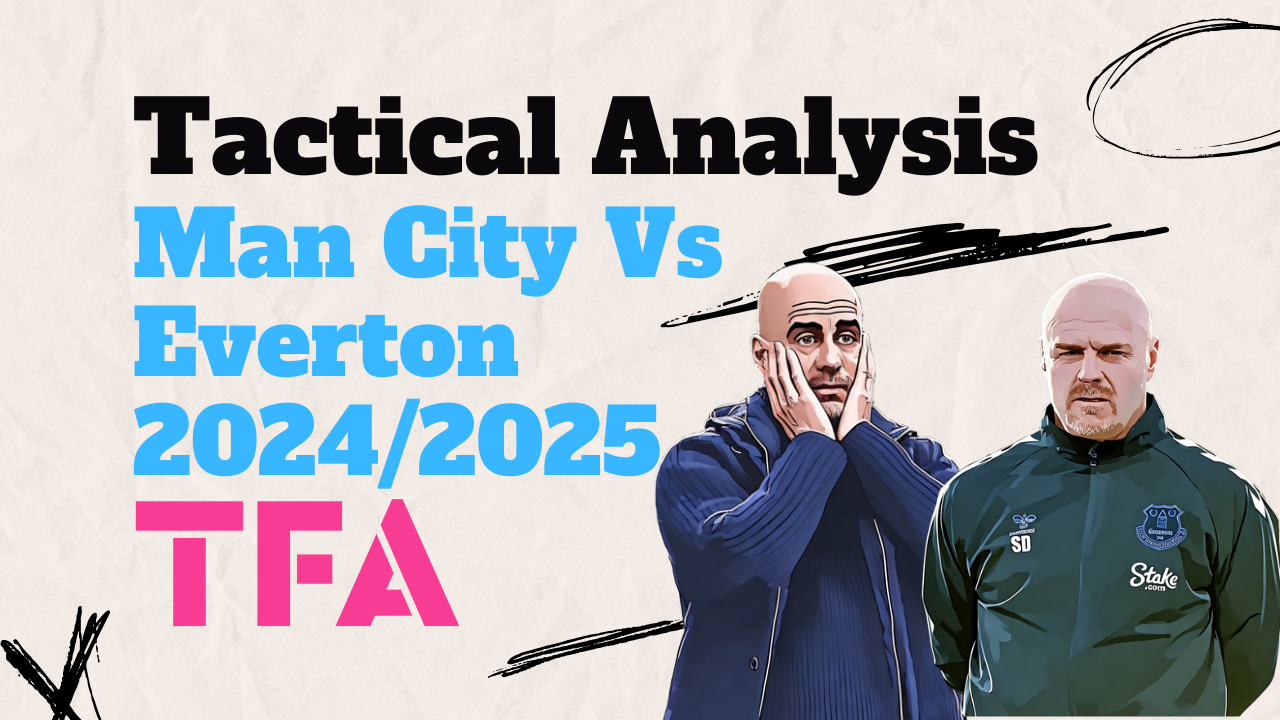




Comments